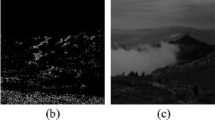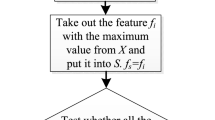Abstract
Spatial rich model (SRM) steganalysis feature is formed by high-order statistics collected from image noise residuals. These statistics are simply rescaled before machine learning. It is noted that SRM features of different cover images are very different. In this paper, we propose a feature normalization method based on random feature-subsets (NRS) for SRM. We randomly draw feature-subsets from SRM feature. Then these feature-subsets are normalized by using per-sample rescaling method to make the feature-subsets of different images have the same 1-norm (the sum of all elements). The proposed NRS method can adjust the feature distribution and increase the feature diversity. The normalized feature-subsets can achieve better detection performance and also can be used as a useful complement for the existing steganalysis features. Experimental results show that: (1) a small amount of normalized feature-subset supplement can obviously improve the detection performance of SRM feature; (2) under the same dimensionality, the proposed NRS version feature can achieve a better detection accuracy than that of original feature; (3) the proposed NRS method is applicable to projections of spatial rich model feature; (4) compared with steganalysis feature extraction, the computational time of NRS can be negligible.





Similar content being viewed by others
Explore related subjects
Discover the latest articles, news and stories from top researchers in related subjects.References
Anthony TH, Li S (2015) Handbook of digital forensics of multimedia data and devices. IEEE Press, New York
Arpit D, Zhou Y, Kota BU, Govindaraju V (2016) Normalization propagation: A parametric technique for removing internal covariate shift in deep networks. In: Proceedings of the 33 rd international conference on machine learning, vol 48. New York, NY, USA
Bas P, Filler T, Pevný T (2011) Break our steganographic system—the ins and outs of organizing boss’. In: Filler T, Pevný T, Ker A, Craver S (eds) 13th international conference of information hiding, lecture notes in computer science, Prague, Czech Republic, vol 6958, pp 59–70
Böhme R (2010) Advanced statistical steganalysis. Springer, Berlin
Breiman L (1996) Bagging predictors. Mach Learn 24:123–140
Chen Y, Lai D, Qi H (2016a) A new method to estimate ages of facial image for large database. Multimed Tools Appl 75(5):2877–2895
Chen Y, Tang S, Zhou L, Wang C, Du J, Wang T, Pei S (2016) Decentralized clustering by finding loose and distributed density cores. Inf Sci. doi:10.1016/j.ins.2016.08.009
Cogranne R, Sedighi V, Fridrich J, Pevn T (2015) Is ensemble classifier needed for steganalysis in high-dimensional feature spaces? In: IEEE international workshop on information forensics and security. Italy, Rome, pp 1–5
Cortes C, Vapnik V (1995) Support-vector networks. Mach Learn 20(3):273–297
Ester M, Kriegel H, Sander J, Xu X (1996) A density-based algorithm for discovering clusters in large spatial databases with noise. In: Simoudis E, Han J, Fayyad U (eds) Kdd, vol 96. AAAI Press, Menlo Park, CA, pp 226–231
Filler T, Fridrich J (2010) Gibbs construction in steganography. IEEE Trans Inf Forensics Secur 5(4):705–720
Fridrich J, Kodovský J (2012) Rich models for steganalysis of digital images. IEEE Trans Inf Forensics Secur 7(3):868–882
Geng X, Yin C, Zhou Z (2013) Facial age estimation by learning from label distributions. IEEE Trans Pattern Anal Mach Intell 35(10):2401–2412
Goljan M, Fridrich J, Cogranne R (2014) Rich model for steganalysis of color images. In: IEEE workshop on information forensic and security. Atlanta, GA
Gu B, Sun X, Sheng V (2016) Structural minimax probability machine. IEEE Trans Neural Netw Learn Syst. doi:10.1109/TNNLS.2016.2544779
Holub V, Fridrich J (2012) Designing steganographic distortion using directional filters. In: Fourth IEEE international workshop on information forensics and security. Tenerife, Spain, pp 234–239
Holub V, Fridrich J (2013a) Digital image steganography using universal distortion. In: Puech W, Chaumont M, Dittmann J, Campisi P (eds) Proceedings of the first ACM workshop on Information hiding and multimedia security. France, Montpellier, pp 59–68
Holub V, Fridrich J (2013b) Random projections of residuals for digital image steganalysis. IEEE Trans Inf Forensics Secur 8(12):1996–2006
Holub V, Fridrich J (2015) Low complexity features for JPEG steganalysis using undecimated DCT. IEEE Trans Inf Forensics Secur 10(2):219–228
Ioffe S, Szegedy C (2015) Batch normalization: accelerating deep network training by reducing internal covariate shift. In: 32nd international conference on machine learning (ICML 2015), vol 1, pp 448–456
Kodovský J, Fridrich J, Holub V (2012) Ensemble classifiers for steganalysis of digital media. IEEE Trans Inf Forensics Secur 7(2):432–444
Kwon YH, Lobo NV (1999) Age classification from facial images. Comput Vis Image Underst 74(1):1–21
Lai D, Chen Y, Luo X, Du J, Wang T (2016) Age estimation with dynamic age range. Multimed Tools Appl. doi:10.1007/s11042-015-3230-0
Li F, Zhang X, Chen B, Feng G (2013) JPEG steganalysis with high-dimensional features and Bayesian ensemble classifier. IEEE Signal Process Lett 20(3):233–236
Luo X, Song X, Li X, Zhang W, Lu J, Yang C, Liu F (2016) Steganalysis of hugo steganography based on parameter recognition of syndrome-trellis-codes. Multimed Tools Appl 75(13):13,557–13,583
Lyu S, Farid H (2002) Detecting hidden messages using higher order statistics and support vector machines. In: 5th international workshop on information hiding, Lecture notes in computer science, vol 2578, pp 340–354
Lyu S, Farid H (2006) Steganalysis using higher-order image statistics. IEEE Trans Inf Forensics Secur 1(1):111–119. doi:10.1109/TIFS.2005.863485
Maaløe L, Sønderby CK, Sønderby SK, Winther O (2016) Auxiliary deep generative models. In: Proceedings of the 33rd international conference on machine learning, vol 48. New York, NY, USA
Mohammadi FG, Abadeh MS (2014) A new metaheuristic feature subset selection approach for image steganalysis. J Intell Fuzzy Syst 27(3):1445–1455
Ng A (2011) Linear regression ii: feature scaling. http://openclassroom.stanford.edu/MainFolder/VideoPage.php?course=MachineLearning&video=03.1-LinearRegressionII-FeatureScaling&speed=100/. Accessed 8 Dec 2015
Ng A, Ngiam J, Foo CY, Mai Y, Suen C (2013) Data preprocessing. http://ufldl.stanford.edu/wiki/index.php/Data_Preprocessing. Accessed 8 Dec 2015
Pevný T, Bas P, Fridrich J (2010) Steganalysis by subtractive pixel adjacency matrix. IEEE Trans Inf Forensics Secur 5(2):215–224
Raschka S (2015) Feature scaling and normalization. http://www.tuicool.com/articles/qYN3Yve. Accessed 22 Feb 2016
Rodriguez A, Laio A (2014) Clustering by fast search and find of density peaks. Science 344(6191):1492–1496
Sønderby CK, Raiko T, Maaløe L, Sønderby SK, Winther O (2016) Ladder variational autoencoders. In: NIPS 2016: annual conference on neural information processing systems. Barcelona, Spain
Song X, Liu F, Yang C, Luo X, Zhang Y (2015) Steganalysis of adaptive JPEG steganography using 2D Gabor filters. In: ACM workshop on information hiding and multimedia security, pp 15–23
Wang P, Wei Z, Xiao L (2016a) Fast projections of spatial rich model feature for digital image steganalysis. Soft Comput. doi:10.1007/s00500-015-2011-z
Wang P, Wei Z, Xiao L (2016b) Pure spatial rich model features for digital image steganalysis. Multimed Tools Appl 75(5):2897–2912
Wu A, Feng G, Zhang X, Ren Y (2016) Unbalanced JPEG image steganalysis via multiview data match. J Vis Commun Image Represent 34:103–107
Yu J, Zhang X, Li F (2016) Spatial steganalysis using redistributed residuals and diverse ensemble classifier. Multimed Tools Appl 75(21):13,613–13,625
Zhang Y, Luo X, Yang C, Liu F (2016) Joint jpeg compression and detection resistant performance enhancement for adaptive steganography using feature regions selection. Multimed Tools Appl. doi:10.1007/s11042-016-3914-0
Zou D, Shi YQ, Su W, Xuan G (2006) Steganalysis based on markov model of thresholded prediction-error image. In: Proceedings of the IEEE international conference on multimedia and expo, Toronto, Canada, pp 1365–1368
Acknowledgements
The authors would like to thank the Network Center of Anhui University of Technology (AHUT) for providing cloud services to support this work. This study was funded by National Natural Science Foundation of China (Grant Nos. 61302178, 61105020), Foundation for Major Program of Education Bureau of Anhui Province (Grant No. KJ2015ZD09) and Excellent Youth Foundation of Anhui University of Technology (Grant No. z10097).
Author information
Authors and Affiliations
Corresponding author
Ethics declarations
Conflict of interest
All the authors and the Network Center of Anhui University of Technology declare that they have no conflict of interest.
Ethical approval
This article does not contain any studies with human participants or animals performed by any of the authors.
Additional information
Communicated by V. Loia.
Rights and permissions
About this article
Cite this article
Wang, P., Wei, Z. & Xiao, L. Spatial rich model steganalysis feature normalization on random feature-subsets. Soft Comput 22, 1981–1992 (2018). https://doi.org/10.1007/s00500-016-2459-5
Published:
Issue Date:
DOI: https://doi.org/10.1007/s00500-016-2459-5




